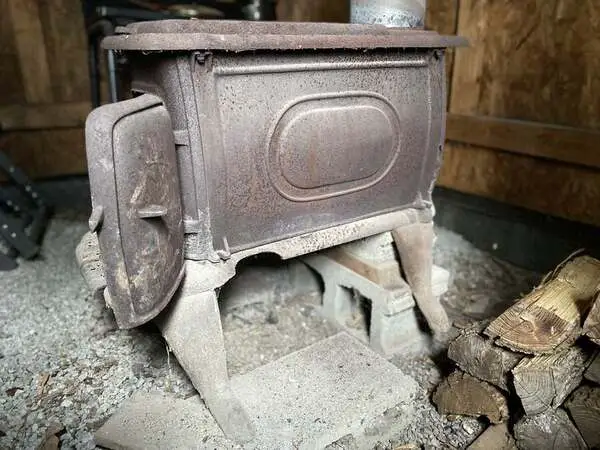Firelighters are an amazing little gadget that can help you start a fire in almost any location. From bonfires to backyard firepits, they can get a blaze going in a pinch!
With their ease of use and incredible utility, can you use firelighters in a wood burning stove?
Let’s take a look into why and how firelighters can be an excellent tool for you to use in your wood burning stove.
Table of Contents
- Can You Use Firelighters in a Wood-Burning Stove?
- Firelighters vs. Fire Wood Explained
- What Materials are Not Safe for Burning in a Wood Stove?
- Other Tips For Using Your Wood-Burning Stove
Can You Use Firelighters in a Wood-Burning Stove?
You can use firelighters in a wood-burning stove, but you shouldn’t use this as your only fuel source. This isn’t a safety concern or law, but is, rather a question of efficiency.

When it comes to burning materials in a wood stove, there’s a lot of leeway with what you can burn. You’ve likely heard of people burning paper, cardboard, and even wood pellets in a wood stove.
Firelighters burn out relatively quickly compared to wood and are much more expensive.
Firelighters are great for starting fires but not for keeping fires going.
Imagine trying to keep a campfire going throughout the day to prevent mosquitos with hundreds of firelighters. This would be very inefficient.
Firelighters are meant to be used similarly to small pieces of kindling.
After getting your smallest fuel ignited, light your firelighter to provide a long-lasting fuel source to ignite your bigger logs. I often light newspaper on fire, then ignite a firelighter with the paper and use that to get normal wood logs to burn.
While this isn’t always necessary, it can make building a fire easier.
Related: How to Cool Down a Wood Stove Quickly (5 Safe Methods)
Firelighters vs. Fire Wood Explained
If you understand what you should use firelighters for, you may wonder why you shouldn’t use firelighters as your fuel source. The simple answer is that firelighters are expensive and short lasting.
Wood burning in a wood stove is measured in cords, and most families will burn about 3 cords of wood over the winter. This roughly translates to 6,000 lbs (2,722 kg) of material.
If you were to buy this amount of firelighters, you’d need to buy roughly 5,335 packets of firelighters, with a price tag of around $64,000. Three cords of wood, alternatively, might cost you $750 total.
Firewood is the cheaper and more efficient option. Although firelighters are great for starting a fire, they wouldn’t be able to keep a fire going efficiently.
Even aside from these reasons, firelighters aren’t meant to be used as fuel in a fire. They are meant to help start the fire, but that’s it.
Hypothetically, you could use firelighters as your only heat source in a wood-burning stove, but that would be like using a rug as a blanket.
What Materials are Not Safe for Burning in a Wood Stove?

While some firefighters are made of organic material or other fire-safe materials, there are many different things you shouldn’t burn in your wood stove. There are many objects that, if burned, release toxins into the air that can harm your lungs.
For example, burning plastic, styrofoam, or trash should never occur in a wood stove. These materials often contain toxins that, when burned, are dispersed into the air and can cause health issues.
Further, wood that has been pressure treated, sealed, or painted can’t be burned.
Burning the wrong type of wood or fuel in your stove can cause more dust and particulate production.
These are often treated with materials that are safe to touch but, if burned, turn into cancer-causing agents, so you’ll want to avoid burning these objects.
There are also some things that you shouldn’t burn because they will burn too hot for your wood stove.
Coal and charcoal, for example, can’t be burned in a wood stove. They burn too hot for your stove, which can cause potential damage to the stove, materials surrounding the stove, or to your stove’s chimney.
Other Tips For Using Your Wood-Burning Stove
Understanding what you can and can’t burn in your wood-burning stove, there are some other things you should know about these devices.
It’s important to do regular maintenance on your stove to prevent unexpected fires and ensure that your stove is working correctly.
You should clean your chimney once a year, regularly remove excess ash and soot, and replace broken pieces.
Improper maintenance on your stove can cause some issues down the line. For instance, you should regularly make sure that there are no leaks. Leaks and other issues can kick smoke into the surrounding area.
Further, when using your wood stove, be sure to know how air is getting into your fire.
Fires need oxygen in order to thrive, so knowing how your stove takes in oxygen is important both to ensure that your fire burns efficiently and in case you need to put your fire out quickly by cutting off airflow.
As a helpful tip, you should learn where the dampers are on your stove, how they work, and what you can do in emergencies.





